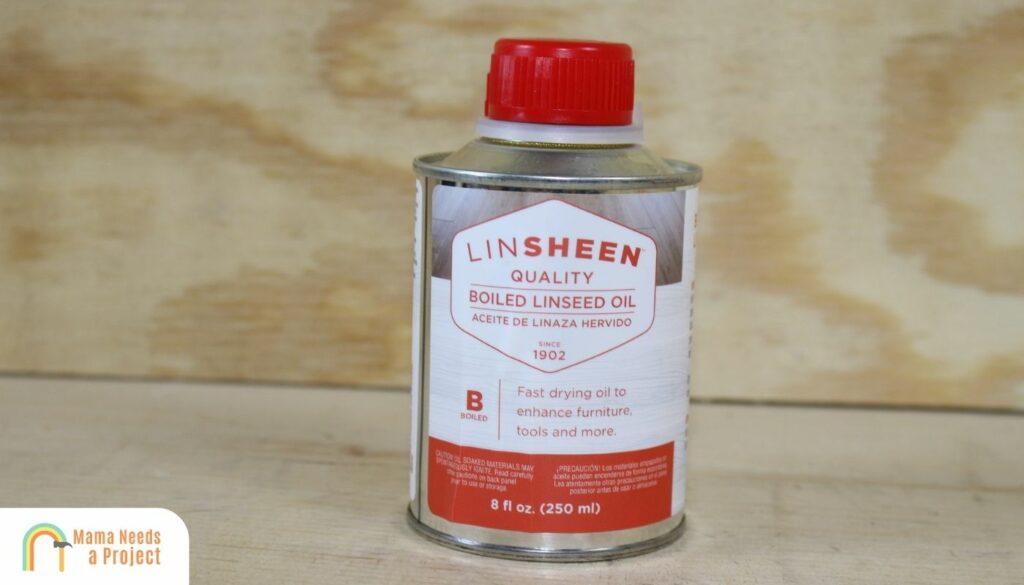How Long Does Linseed Oil Take to Dry? (Tips for Faster Drying!)
If you’re a painter, woodworker, or DIYer, there’s a good chance you’re somewhat familiar with linseed oil. This unique oil can be applied to the surfaces of furniture, wood crafts, and other products for added protection for your projects.
While linseed oil is a great, eco-friendly alternative to traditional stains and finishes, it has one significant disadvantage to other, more commonly used finishes. It takes forever to dry! As a result, people are hesitant to use linseed oil if they think it will slow down their project.
In this post, I’ll answer the question “how long does linseed oil take to dry?”, how you can speed up the process, and much more. Let’s dig in!
- Linseed oil can take anywhere from a few days to over a week to dry completely but it will depend on the type used.
- Boiled linseed oil takes around 24 hours to 72 hours to dry.
- To cure completely, you can expect it to take at least a month depending on the conditions it’s applied.
How Long Does Linseed Oil Take to Dry?
You’ve likely heard of paints, finishes, and stains that are touted as fast-drying and will harden in less than 20 minutes. Unfortunately, linseed oil is not among these products.
In ideal conditions, it can take anywhere from three to ten days for linseed oil to dry completely. On average, you can also expect it to be anywhere from 12 hours to three days before the oil is dry enough to add a second coat, if necessary.
Because of how long it takes linseed oil to dry, it isn’t always the best option for DIYers who are on a time crunch. If you have the time to wait, however, linseed oil provides a beautiful, protective finish for wood products.
Check out this linseed oil vs tung oil comparison to find out which oil is best for your project!
How Long Does Raw Linseed Oil Take to Dry?
Raw linseed oil has the slowest drying process of any type of linseed oil. On average, you can expect to wait anywhere from three to ten days for raw linseed oil to dry completely.
However, there are various factors that can extend or reduce the drying time for raw linseed oil, as I’ll explore later.
How Long Does Boiled Linseed Oil Take to Dry?

If you want linseed oil that has a faster drying time, boiled linseed oil is the way to go. Contrary to what the name implies, boiled linseed oil isn’t created by literally boiling linseed oil.
Instead, you get it by combining raw linseed oil with standing linseed oil and other additives. You then treat the concoction with hot air to achieve the “boiled” effect.
Because boiled linseed oil gets treated with hot air, it dries in one to three days which is a huge difference from the one+ week for raw linseed oil. Boiled linseed oil is also much thinner than the raw version, further helping with drying time.
How Long Does Polymerized Linseed Oil Take to Dry?
Polymerized linseed oil is created in a similar fashion as boiled linseed oil but with several key differences. First, you take raw linseed oil and heat it up to 572 degrees Fahrenheit, which is much hotter than boiled linseed oil.
Next, it’s crucial that the heating process happens in a vacuum so that there is no oxygen. The total process takes several days to do, but it makes it so that the drying time after application is even shorter than that of boiled linseed oil.
While this is the most complicated way of making linseed oil, it will result in the shortest drying and curing time.
What is the Linseed Oil Curing Time?
If you think linseed oil takes a long time to dry, it’s nothing compared to the curing time.
- Raw Linseed Oil- If you use linseed oil in its raw, natural state, it can take anywhere from two weeks to three months for the linseed oil to fully cure.
- Boiled and Polymerized Linseed Oil- In addition to having a faster drying time, boiled and polymerized linseed oil also has a substantially faster curing time of 30 to 40 days.
Factors That Affect Linseed Oil Drying Time
While the type of linseed oil you use will drastically affect drying time, there are other factors to consider.
How Much Oil You Use
One of the biggest mistakes people make when using linseed oil is that they apply way too much. Because of how thick it is, you only need a thin coat of linseed oil to protect wood surfaces.
Therefore, by wiping away excess oil with a rag or brush, you can shorten the dry time by several hours or days.
Air Movement
If you leave your linseed oil sitting in a still, motionless environment, you’ll be waiting forever for it to dry. Instead, consider placing a fan near whatever you applied the oil to, or place it in an area with a cross-breeze. The more air movement there is, the faster your linseed oil will dry.
Humidity
Ideally, you should keep things with linseed oil applications in dry environments free from moisture and humidity.
Dryness of the Wood
The type of wood you’re finishing and how dry it is will significantly affect linseed oil drying time. Dry wood will act like a sponge and soak up linseed oil faster than moist wood, so it’s important to keep it as dry as possible.
Temperature
Finally, cool air will keep linseed oil from evaporating, which is an important part of the drying and curing process. To keep this from happening, keep things with drying oils in a warm area to encourage evaporation.
How to Speed Up the Drying Process
The best way to make linseed oil dry faster is to boil or polymerize it. If you don’t want to do this yourself, you can purchase pre-boiled and polymerized linseed oil from your local store.
Aside from using boiled or polymerized linseed oil, there are other things you can do to speed up the drying process.
Add Turpentine
One of the most common and effective ways to speed up the drying process is to add a bit of turpentine to the oil. Turpentine is a powerful, pungent solvent that’s often used in the painting industry as a paint additive and thinner.
By adding a small amount of turpentine to your linseed oil before applying it, your oil will be thinner and dry faster.
Add Mineral Spirits
In addition to using turpentine as a thinning agent, you can also add mineral spirits to your linseed oil. Mineral spirits will fulfill the same function as turpentine and make linseed oil thinner, resulting in a faster drying time.
Increase Airflow
As we said above, a little bit of airflow will go a long way in helping linseed oil dry faster. If a natural cross-breeze isn’t an option, set a fan next to the oiled application.
Turn Up the Thermostat
Turning the heat up doesn’t necessarily help linseed oil dry faster, but it will keep the process from being delayed.
Go Easy on the Oil
Finally, immediately after applying linseed oil, wipe away excess oil with a rag. More linseed oil doesn’t necessarily mean more protection, but it does mean a longer drying time.
Does Thinning Linseed Oil Help It Dry Faster?
There’s no doubt that thinning linseed oil helps it dry faster, but it may not affect curing time. However, while adding drying agents to make linseed oil thinner will speed up drying time, you want to be careful not to make it too thin.
The whole reason that woodworkers and DIYers like linseed oil is because of its ability to penetrate deep into the wood and provide the most comprehensive protection. If you make linseed oil too thin, it won’t penetrate as deep and, therefore, won’t offer as much protection.
How to Thin Linseed Oil
If you’re determined to use linseed oil and want to make it thinner with a drying agent, here’s what you need to know.
Adding Turpentine
Mix turpentine and linseed oil at a 1:1 ratio. Anything more will take away from the oil protection benefits, while anything less won’t do an effective job of thinning the oil.
Adding Mineral Spirits
Mix mineral spirits and linseed oil at a 2:1 ratio, mixing two parts mineral spirits to one part linseed oil. Mineral spirits aren’t quite as potent as turpentine, which is why it requires slightly more to achieve the same effect.
Are you wondering how to apply linseed oil on wood? Check out the video below!
FAQs
How do you make linseed oil dry faster?
The best way to make linseed oil dry faster is to use boiled linseed oil and mix it with a drying agent.
How long does it take for linseed oil to dry on wood?
Raw linseed oil can take anywhere from three to ten days to dry, while boiled and polymerized linseed oil will dry in one to three days.
How long do you leave linseed oil on before wiping it?
You can wipe away excess linseed oil immediately after applying it. To clean the wood surface after applying the oil, however, you should wait until it’s completely dry.
Final Thoughts
As you can see, while there are ways to speed up the linseed oil drying process, there’s only so much you can do without eliminating its protective benefits. It’s an oil that requires patience and practice to use but that rewards you with more protection than most other stains and finishes.
Therefore, if you’re not pressed for time and want to use one of the best finishes in the industry, linseed oil is a great option.
Linseed oil dries in around 3 to 10 days under normal conditions, but there are several factors that can affect this.


